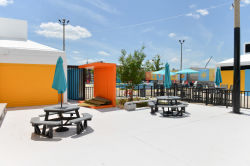Thomas Greene Playground
Thomas Greene Playground
This parkland honors local community leader and activist Thomas Greene (1911–1988). Born on March 26, 1911 in Savannah, Georgia, Greene became a permanent resident of New York City in 1932. He lived in the Gowanus Housing Project, and in 1949, he met and married Agnes Washington. Until his retirement in 1976, he worked for Cornell University’s New York City offices.
Following his retirement, Greene turned his attention towards community activities. He became president of the Gowanus Tenant Association and served on the Board of Directors for the Renaissance Development Corporation and the Colony South Brooklyn Houses. In addition, he participated in Community Board 6, and Area Policy Board 6. He volunteered as supervisor of the Gowanus Senior Citizen Center, and was an active member of Bethel Baptist Church. On January 17, 1988, Greene passed away. He left behind his wife, two sons, a daughter, eight grandchildren, and six great-grandchildren. Moreover, he left members of the community with fond memories of a man who devoted his time and energy to the betterment of his neighbors.
Thomas Greene Playground, bounded by Third Avenue, and Nevins, DeGraw, and Douglass Streets, is located in the Gowanus neighborhood of Brooklyn. The origin of the term “gowanus” is uncertain. The popular theory claims that it comes from Gowane, either a sachem (North American Indian chief) of the Canarsee tribe or a member of the Mohawk tribe. Regardless of its namesake, when the Dutch settled the area in the 1640s, they gradually displaced the existing Native American population. Slowly, the rich plant life, and wild animals of Gowanus died off as well.
In August 1776, during the Battle of Brooklyn, Gowanus saw some of the most brutal fighting of the Revolutionary War. During the battle, the British killed 256 American soldiers, and wounded or captured another hundred. General George Washington (1732-1799), nevertheless, masterminded a brilliant, nighttime retreat to Manhattan that ensured that the American Continental Army would live to fight another day.
In the late 1840s, Edwin Clarke Litchfield (1815-1885), who worked as a railroad businessman and as a lawyer, expanded the Gowanus Creek into a canal. In addition to the immediate effects of his canal on Brooklyn’s commerce, he influenced much of Brooklyn’s later development through real estate. By purchasing huge tracts of farmland during the 1850s and then selling them to developers after the Civil War, he made great profits. Today, his beautiful, Italianate villa, off Prospect Park West, serves as the Parks headquarters in Brooklyn.
The Gowanus Canal area attracted industrial firms to the area, whose employees moved in nearby. Unfortunately for the workers living in the area, as industry-expanded waste severely polluted the canal. The Brooklyn Daily Eagle called it “an open cesspool” in 1893. Due to its manmade modifications, the canal’s northern end was not naturally cleaned by the tides. To remedy this, the City constructed a flushing tunnel that connected the canal to Buttermilk Channel. The tunnel was damaged by workmen in the 1960s and left inactive until it was repaired in 1989.
In addition to the canal, Gowanus contains other transportation landmarks, including the City’s tallest subway viaduct (the F line at Smith and 9th Street, 87.5 feet above the canal) and the Carrol Street Bridge (1889), one of only a few retractile bridges remaining in the United States.
The City of New York first acquired this property in 1938. Parks’ jurisdiction over the property, however, extends back to three years earlier. When the playground first opened in 1935, it was unofficially known as Double D Playground, simply because it is between DeGraw and Douglass Streets. In 1988, local law renamed the park in honor of Thomas Greene. Ten years later, a $213, 659 renovation was completed, funded by the Brooklyn Borough President, Howard K. Golden. New play equipment, safety surfacing, and handball courts were added. The playground now contains camel animal art, benches, play equipment, a drinking fountain, picnic tables, basketball and handball courts, and flagpole with a yardarm displaying the flags of Parks, the City of New York, and the United States of America. Thomas Greene Playground serves both as a memorial to a dedicated community leader and a place of rest and recreation for people of all ages.
Check out your park's Vital Signs
Clean & Safe
Green & Resilient
Empowered & Engaged Users
Share your feedback or learn more about how this park is part of a
Vital Park System









